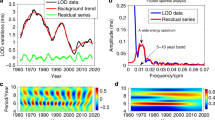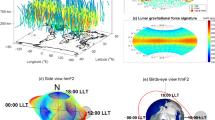Abstract
CHIMONAS and Hines1,2 have suggested that a solar eclipse might generate gravity waves in the atmosphere. During solar eclipse the localised cooling of the atmosphere in the lunar shadow causes an energy imbalance and the shadow moving at supersonic speed across the Earth's surface could be a continuous source of gravity waves propagating to great distances in the atmosphere. These quasi-periodic wave perturbations in the ionospheric electron density, caused by the coupling between the ionised and the neutral particles, have been detected by various investigators3–5 at middle and high latitude stations away from the path of the eclipse shadow. Hajkowicz6 has reported the observation of perturbations of quasi-peniods of less than 2 min, after the October 1976 eclipse. We report here the observation of quasi-periodic fluctuations in Faraday rotation angle Ω and the 1 MHz modulation phase delayφ of 40 MHz transmissions from ATS-6 geosynchronous satellite recorded at Trivamdrum (dip 0°57′S, geographical longitude 76°57′E) during the partial solar eclipse on 29 April 1976. φ directly gives columnar electron density integrated along the radio ray path from the satellite to the receiver; whereas Ω gives columnar integrated electron density only up to an altitude of 2,000 km because of the weightage by the component of the geomagnetic field along the ray path. For ATS-6 to Trivandrum ray path geometry, a change of 10° in Ω will be produced by a change of 0.47×1016 el. m–2 of electron (el.) content. In contrast to this, 10° change in φ will be produced by a change of 0.34 × 1015el. m–2. The accuracy of measurement of both Ω and φ is better than 1°.
This is a preview of subscription content, access via your institution
Access options
Subscribe to this journal
Receive 51 print issues and online access
$199.00 per year
only $3.90 per issue
Buy this article
- Purchase on Springer Link
- Instant access to full article PDF
Prices may be subject to local taxes which are calculated during checkout
Similar content being viewed by others
References
Chimonas, G. & Hines, C. O. J. geophys. Res. 75, 875 (1970).
Chimonas, G. & Hines, C. O. J. geophys. Res. 76, 7003 (1971).
Carlson, H. C. et al. Nature 226, 1124 (1970).
Larfold, G. M., Jurgens, R. M., Vesecky, J. F. & Warhbann, T. W. J. atmos. terr. Phys. 34, 733 (1972).
Davies, M. & Da Rosa, A. V. Nature 226, 1123 (1970).
HajkowWicz, L. A. Nature 226, 147 (1970).
Blackman, R. B. & Tukey, J. W. Measurement of Power Spectra (Dover, London).
Georges, T. M. ESSA tech. Rep. IER 57-ITSA, 54 (1967).
Author information
Authors and Affiliations
Rights and permissions
About this article
Cite this article
VAIDYANATHAN, S., RAGHAVA REDDI, C. & KRISHNAMURTHY, B. Quasi-periodic fluctuations in electron content during a partial solar eclipse. Nature 271, 40–41 (1978). https://doi.org/10.1038/271040b0
Received:
Accepted:
Published:
Issue Date:
DOI: https://doi.org/10.1038/271040b0
This article is cited by
-
Temperature variation in the mesosphere during solar eclipse
Journal of Earth System Science (1983)
-
On the effect of the partial solar eclipse of 29 April 1976 on electron content
Journal of Earth System Science (1980)
Comments
By submitting a comment you agree to abide by our Terms and Community Guidelines. If you find something abusive or that does not comply with our terms or guidelines please flag it as inappropriate.



